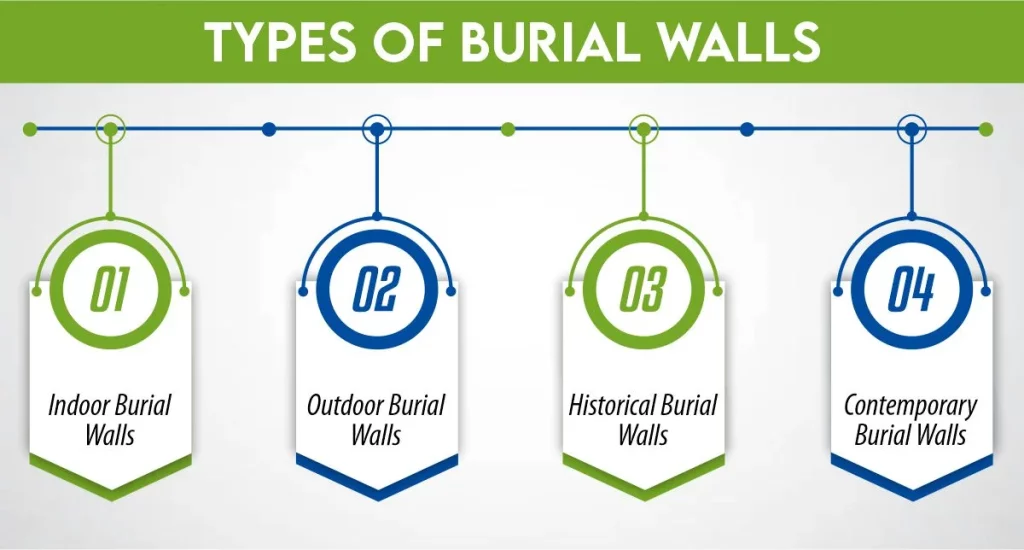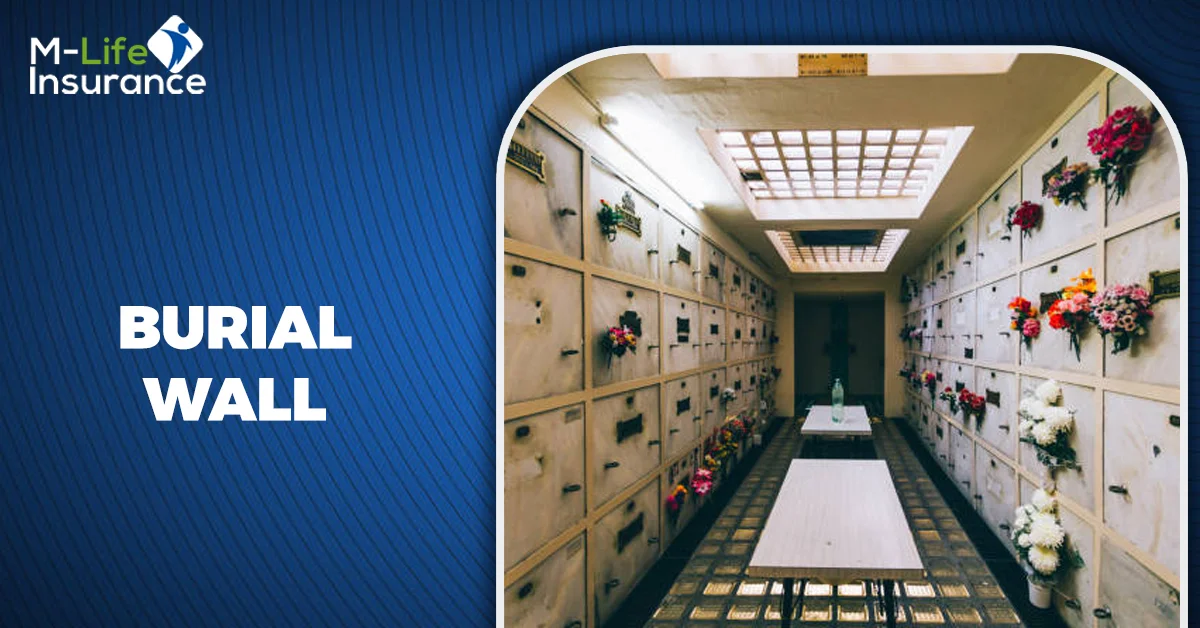Are you curious how burial walls offer a unique solution for memorializing loved ones? Burial walls may be new to you, but they’re worth discovering. These walls provide a special place to remember our loved ones and have a unique charm. Imagine combining the best of tradition with a touch of modern style. That’s what the burial wall is all about—a way to honor those we cherish in a simple yet beautiful manner. These walls offer a fresh take on memorialization, making it easy to create lasting memories in a practical and attractive way. Let’s talk about something unique to unravel the mystery of burial walls. Get ready with us to discover a modern and practical approach. Let’s get started!
Understanding of Burial Wall:
Burial walls, known more formally as columbarium walls, represent a meaningful and modern approach to memorializing the departed. But what are these structures, and why have they become a preferred choice for many?
What is Burial Wall
Burial walls, also known as columbarium walls, represent a significant shift in commemorating and remembering those who have passed away. A burial wall consists of a series of niches constructed within a wall to contain urns filled with the deceased’s ashes. Predominantly located in places of remembrance like cemeteries, memorial parks, or specific religious buildings, each niche is securely sealed and typically features a plaque that bears the name and other details of the person memorialized.
The design of a columbarium wall is both practical and deeply symbolic. More than that, it offers a respectful and honorable way to keep the memory of loved ones alive. These walls, with their solemn presence, serve as a constant reminder of the lives they honor, often harmonizing with the aesthetic beauty of their surroundings, be they natural or artificial.

Types of Burial Walls
It’s a perfect solution to the challenge of space, especially critical in densely populated urban areas. Check some main types:
Indoor Burial Walls:
These are often found in mausoleums, churches, or other indoor memorial facilities. Indoor walls offer a year-round, weather-protected space for visitors. They can be ornately decorated, with a serene and quiet ambiance for reflection and remembrance.
Outdoor Burial Walls:
Typically located in gardens or cemetery grounds, outdoor walls are designed to harmonize with the natural surroundings. They might be constructed with stone or marble materials and beautifully landscaped with flowers, shrubs, and trees.
Historical Burial Walls:
These are found in older cemeteries and memorial sites and often carry significant historical value. They reflect the architectural and cultural styles of the periods in which they were built, offering a window into the past and the evolving traditions of memorialization.
Contemporary Burial Walls:
Modern walls incorporate sleek designs and materials. They often feature newer technologies like glass-fronted niches or digital memorial options. These walls reflect current architectural trends and society’s evolving attitudes toward death and remembrance.
columbarium walls are not just structures but profound symbols of memory, respect, and love. Whether nestled quietly in a church, standing solemnly in a cemetery, or showcasing modern designs in urban settings, they offer a tangible connection to those we’ve lost, ensuring their memories are preserved with dignity and grace.
Difference between a cemetery burial wall and a mausoleum burial wall
The primary difference between cemetery burial walls and mausoleum burial walls lies in their location and the environment they provide for memorializing the deceased.
Cemetery Burial Walls:
Location and Setting: Cemetery walls are typically located outdoors within the grounds of a cemetery. A natural landscape surrounds them, including gardens, trees, and open spaces.
Interaction with Nature: Being outdoors, these walls allow visitors to experience the changing seasons and natural elements, providing a unique sense of connection with the environment.
Material and Design: They are often constructed from durable materials like stone or granite that can withstand outdoor elements. The design might be simpler or blend with the outdoor setting.
Accessibility: These walls are generally accessible during the cemetery’s open hours and offer a more traditional, open-air space for remembrance.
Mausoleum Burial Walls:
Location and Setting: Mausoleum walls are indoors within a mausoleum. This setting offers a more controlled, sheltered environment, protected from the weather.
How Much Does Life Isurance Cost?
Enclosed and Private Space: The indoor setting provides a quiet, private space for reflection and visiting, regardless of outside weather conditions.
Material and Design: Mausoleum walls might feature more intricate designs and can include various materials, including glass-front niches. The interior decor can be more elaborate, offering a different aesthetic experience.
Accessibility: Normally, visitors are not allowed to access the walls of mausoleums except during opening hours, which can provide a more intimate setting.
In summary, while cemetery and mausoleum walls serve the same fundamental purpose of memorializing the deceased, they offer different experiences. Cemetery walls connect with the natural outdoor environment, offering a traditional and open setting, while mausoleum walls provide a more private, weather-independent space with potentially more elaborate designs.
How Much Does a Burial Wall Cost?
When considering a final resting place, many think columbarium walls are dignified and lasting. However, a common question arises: How much does a wall cost? The answer could be more straightforward, as several factors influence the price, making each choice unique.
Factors Influencing the Cost of a Burial Wall
Location: Just like real estate, the location of the columbarium wall plays a significant role in its cost. A niche in a highly sought-after, picturesque cemetery or a prestigious mausoleum can command a higher price.
Type of Niche: The cost varies depending on whether the niche is in an outdoor cemetery wall or an indoor mausoleum. Indoor niches, particularly those in climate-controlled environments, might be priced higher due to additional maintenance and facilities.
Material and Design: The cost is also influenced by the materials used (granite, marble, glass, etc.) and the complexity of the design. Customized or elaborate niches with special features can add to the cost.
Additional Expenses: Remember to factor in the costs of the urn, the plaque or engraving, and any ongoing maintenance or one-time endowment care fees.
Average Cost Ranges
Here’s a general overview:
Outdoor Cemetery Wall Niches: The cost for these niches generally starts at a few hundred dollars and can go up to a few thousand. The lower end of this range typically includes basic outdoor niches in less prominent locations. As you move towards the higher end, the cost reflects niches in more sought-after areas of the cemetery, larger spaces, or those with more elaborate designs.
Indoor Mausoleum Wall Niches: These start in the low thousands and can go much higher, especially for prestigious locations or larger spaces. These niches offer the advantage of a controlled environment, often with more intricate design options.
Choosing a wall is a personal and significant decision. While budgets are important, it’s equally crucial to consider the peace and comfort the location will bring to those who visit. Remember, this decision echoes through generations, a testament to a life well-lived and dearly remembered.’
Purpose and Characteristics of Burial Walls
columbarium wall, an age-old concept with a modern twist, offers a unique blend of tradition and innovation in memorialization. These structures provide a dignified resting place for the departed and reflect a deep cultural significance and evolving design characteristics. Let’s delve into the purpose and defining characteristics of walls.
Purpose of Burial Walls
Memorialization: At its heart, a burial wall is a place for remembering and honoring the deceased. It provides families a physical location to visit, reflect, and pay respects, which can be an important part of the grieving process.
Space Efficiency: In urban areas and regions where land is scarce, walls offer an efficient use of space. Unlike traditional burials, which require large plots of land, columbarium walls can accommodate many individuals in a comparatively small area.
Preservation and Security: These walls protect the remains of the deceased in a secure and preserved environment. This is especially important for indoor columbarium walls, which offer a controlled climate, protecting against external elements.
Accessibility and Permanence: Burial walls provide a long-term, accessible option for memorialization. Unlike graves, which might be subject to relocation or disturbance, niches in the wall typically remain undisturbed, ensuring a permanent memorial site.
Characteristics of Burial Walls
Design and Construction: Burial walls are typically constructed of durable materials like granite, marble, or brick. The design can range from simple and understated to ornate and elaborate, often reflecting the cultural and religious practices of the community they serve.
Types of Niches: The niches within the walls can vary in size and design. Some are designed to hold a single urn, while others can accommodate multiple urns for family members. Glass-fronted niches allow visible memorabilia, whereas stone or marble-fronted niches offer a traditional look.
Location: Walls can be found in a variety of settings. Outdoor columbarium walls are often part of cemetery landscapes, blending with the natural surroundings. Indoor walls can be located in mausoleums, churches, or dedicated memorial buildings, providing a year-round, weather-independent place for visitation.
Cultural and Spiritual Significance: Often, the design and use of burial walls are influenced by cultural and religious traditions.
Environmental Consideration: These walls are more environmentally friendly than traditional burials. They require less land and often involve fewer resources for maintenance, making them a sustainable choice for memorialization.
They are intricately designed, culturally significant structures that offer a sustainable, respectful, and personalized way of memorializing loved ones. Their growing popularity reflects a shift in how societies approach remembrance and use shared spaces to honor the past.
Future Trends in Burial Walls
As we look ahead, burial walls are expected to evolve with technological, environmental, and social trends:
Technological Integration: Future walls may feature digital components, such as interactive plaques or screens, allowing visitors to access rich digital memorials.
Eco-Friendly Design: Emphasis on sustainable materials and practices, like biodegradable urns and green landscaping, will likely increase, reflecting environmental consciousness.
Personalization: Customization in design and memorialization will become more prevalent, offering unique and individualized commemoration options.
Virtual Memorialization: The rise of digital technology could lead to virtual memorial experiences, enabling distant loved ones to connect and pay respects online.
Architectural Innovation: Expect more architecturally significant designs, transforming walls into contemplative, artistic spaces within communities.
Conclusion
In conclusion, burial walls hold a profound significance in modern society, transcending their primary function of memorializing the departed. These structures, with their evolving designs and integrated technologies, are about preserving memories and shaping our contemporary attitudes toward life, death, and remembrance. They are a testament to the changing paradigms in honoring our loved ones, blending tradition with innovation. Columbarium walls encourage us to view death not just as an end but as an integral part of life’s journey, deserving of respect and commemoration. As these walls become more integrated into our social and architectural landscapes, they offer a space for reflection and connection, reminding us of our shared human experiences and the timeless bonds that transcend life. In this way, these walls play a crucial role in shaping our collective perspectives on existence, loss, and the enduring power of memory.

Joyce Espinoza, Expert Life Insurance Agent
Joyce Espinoza is a trusted life insurance agent at mLifeInsurance.com. She’s been in the insurance industry for over ten years, helping people, especially those with special health conditions to find the right coverage. At MLife Insurance, Joyce writes easy-to-understand articles that help readers make smart choices about life insurance. Previously, she worked directly with clients at Mlife Insurance, advising nearly 3,000 of them on life insurance options.


